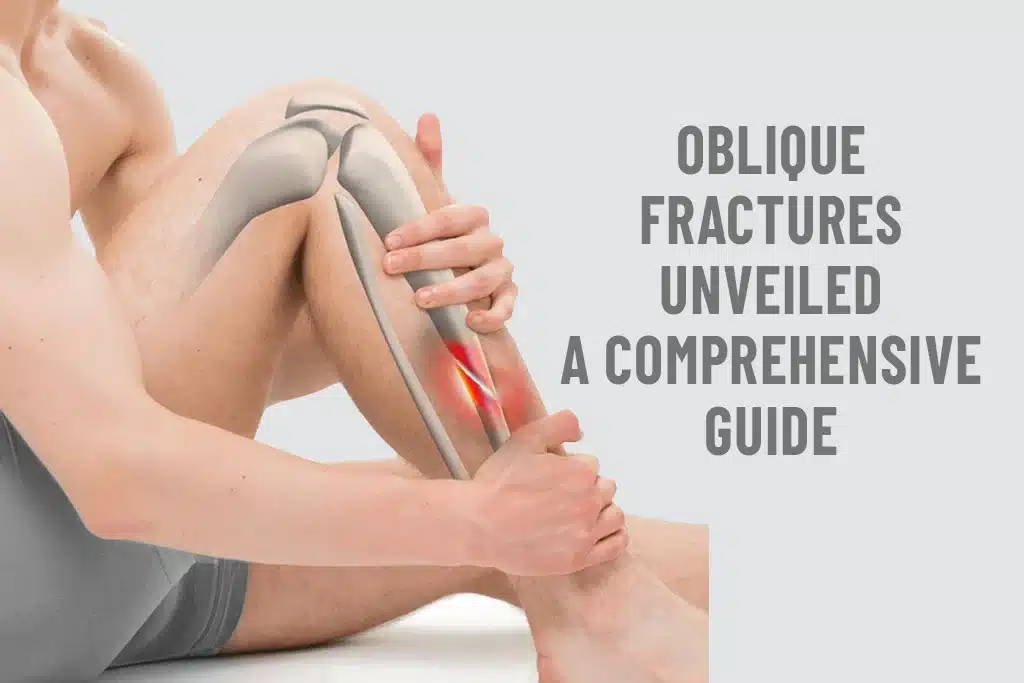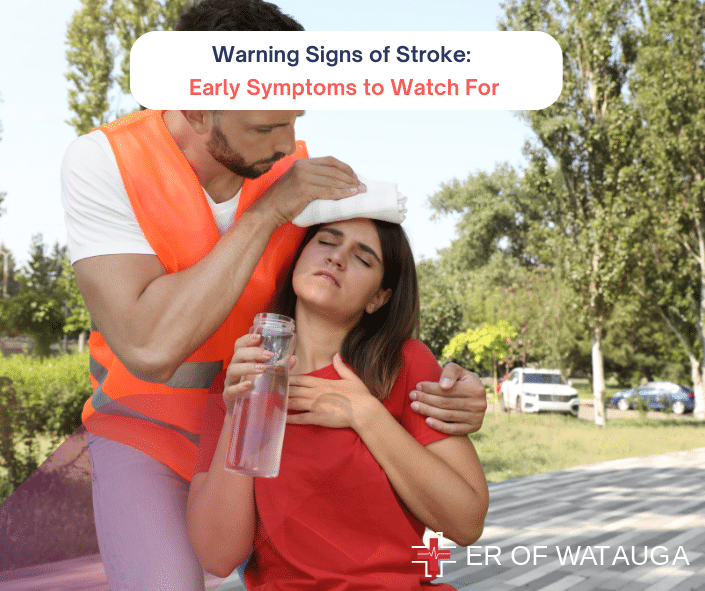Have you ever wondered what sets an oblique fracture apart? Let’s explore together in this detailed overview to discover the ins and outs of oblique fracture. Firstly, this blog will uncover oblique fractures of the world, which will provide you with the necessary information regarding their symptoms and causes. We’ll also discuss different therapeutic modalities that can be adjusted according to your case.
Knowing the medical terms for oblique fractures, their origins, the therapy options, and the permanent prevention measures will enable you to overcome the healing period and fully recover. It’s important to note that if an oblique fracture is suspected then it is the medical care that needs to be quick so that the diagnosis and treatment are not turned down.
What is an oblique fracture?
An oblique fracture is one example of a specific fracture that is characterized by broken bones. Disruptions of your bone happen when the ends of the bone are disconnected because broken in such a way. In such a situation, if the fragmentation is oblique, complete fracture possibly would be the name of it.
In simple terms, this means the line or the outer side of your bone is being cut. The oblique fracture is an inclined break that emerges in long bones such as the leg, elbow, and so forth. Some of the most common include:
- Femur (thigh).
- Tibia (shin).
- Fibula (calf).
- Humerus (upper arm).
- Radius and ulna (forearm).
- Clavicle (collarbone).
Oblique Fracture is always associated with other traumatic events. You, meanwhile, undergo an operation to pin up your bone. For some, a cast or a splint is just enough to allow for the bone to become well again.
The length of complete healing differs with the number of bones broken and how badly they are fractured because of an accident or possibly other factors. Almost everybody(women, the elderly, and the children) needs three to four months to recover from an oblique fracture.
Oblique fractures vs. spiral fractures
Oblique fracture can be described as a situation when your bone is broken in an oblique deformation, at an angle. The fracture that goes straight line across extends through the width of the bone, the most common among the three types is the compound fracture, commonly known as “open” or “compound” fracture. A common cause of fractures is when you hit your bone at an angle or when the bone is lined up in the road but not in the center.
Spiral fractures occur when you fracture your bone at an angle, spiraling as if along the ribs of a spiral staircase. These small brittle bones then spiral tress-like around the bone, making it impossible for him to stand on his own or hold severe injuries. Such happens super often in sports injuries especially when athletes and their bones are twisted and make some terrible moves (like the players when they are tackled in football).
How is an oblique fracture different from a transverse fracture?
Oblique fracture (when your bone is broken at an angle on its width), and transverse fracture (straight on your bone’s width) are the two kinds of fractures that happen. Transverse fractures mean the appearance of horizontal fractures although all of them are at right angles to your bone (unlike your bone)
Whether the tiny notches produced on your fracture turn out as Whistler’s fracture name or any other name, the most important first step is having the doctor examine your initial injury immediately.
How does an oblique fracture occur
An Oblique fracture similar to other finite element analyses in bone fractures may happen to anyone. This is particularly the case because those triggers are usually the results of falls or traumas. It is worth understanding that those at risk of falls are going to encounter an oblique fracture. In the case of osteoporosis (osteoporosis), it has been revealed that a person has a higher chance of getting different types of oblique fractures.
What are the symptoms of an oblique fracture?
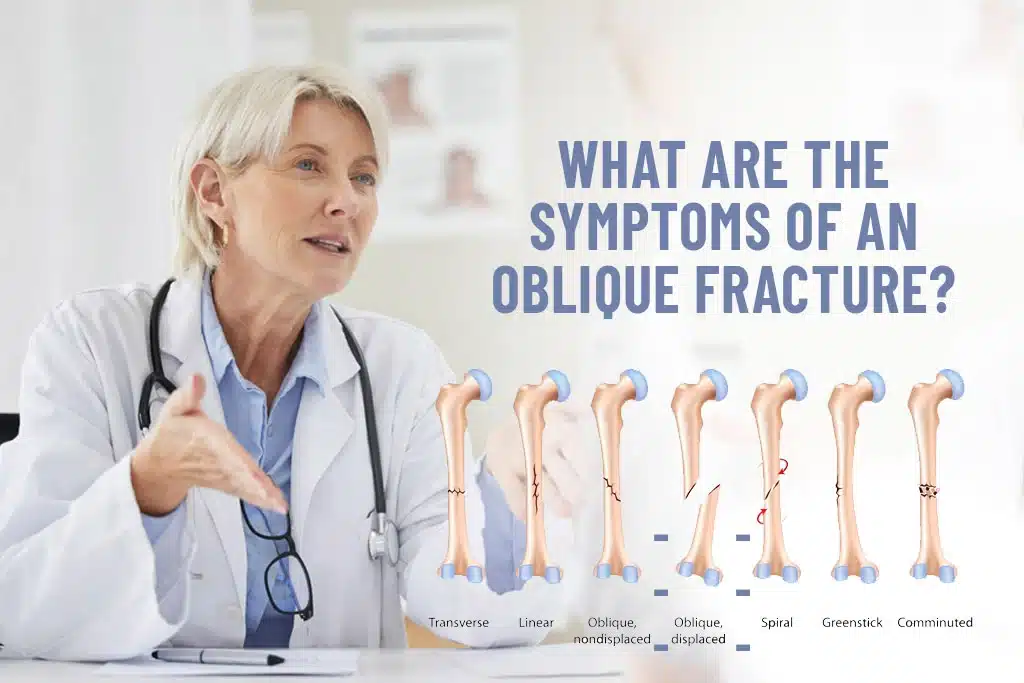
Symptoms of an oblique fracture include:
- Pain
- Swelling
- Tenderness
- Inability to move a part of your body that you usually can
- Bruising or discoloration
- A deformity or bump that’s not usually on your body
Open vs. closed fractures
You may be diagnosed with either a compound or simple fracture by your healthcare provider. In the case of an open fracture, chemically, your bone bursts through your skin. Infection and other complications always go hand in hand with open fractures and therefore there is a possibility of an infection delaying the healing process. Closed fracture also still calls for medical intervention, however, nothing of your bone has gone through your skin.
What is a displaced oblique fracture?
The parts of the fractures that are shifted out of their normal position and those that are not are what these two terms besides displaced and non-displaced mean. Displacement below your ring or middle finger splints means the pieces of the bone moved too much so that a gap formed around the fracture.
Despite the fact the fact that these are non-displaced fractures, the parts of the bone still remain broken, and this is unlike displaced fractures which have been snapped back in position. The greater the fracture damage, the higher the chances of an individual having surgery to recover.
What causes oblique fractures?
Your bones can be influenced by any impact causing the bones to fracture in an oblique way. Most of the time they have undergone rotation to your ear after the impact with your body. The top frequent reasons are traumas, falls, traffic accidents, and sports injuries.
How are oblique fractures diagnosed?
A clinical evaluation and evidence from the imaging tests will be the healthcare provider’s means of diagnosing an oblique fracture.
What tests are done to diagnose an oblique fracture?
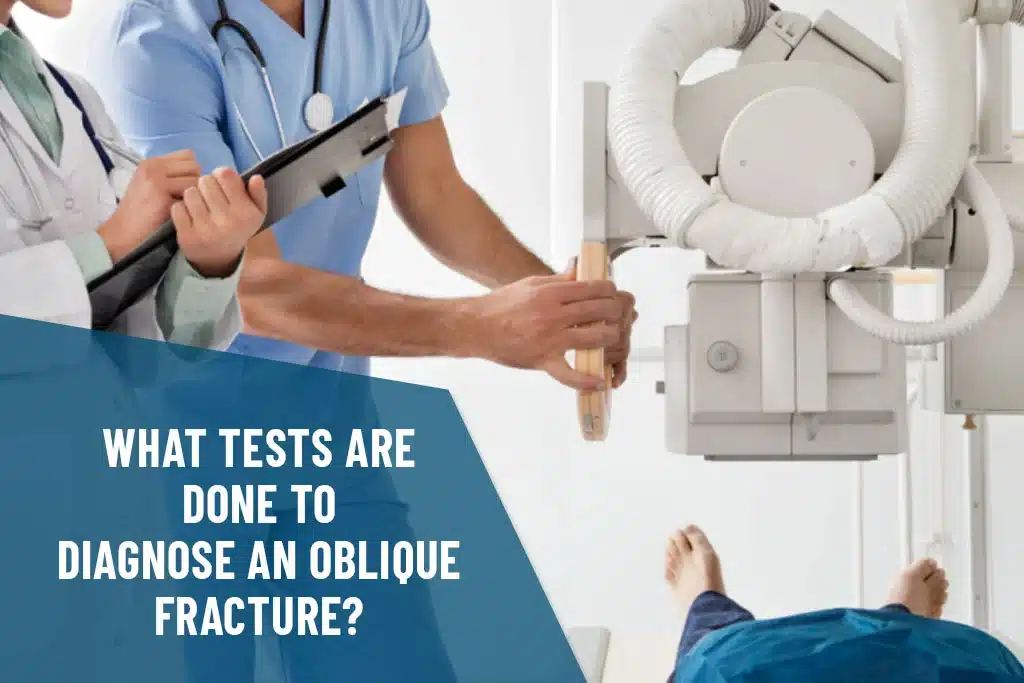
After a physical exam, you’ll likely need at least one of a few imaging tests:
X-rays: The X-ray will determine the oblique or other fractures as well as the adequacy of damage. The bones will show what type of injury the leg has endured.
Magnetic resonance imaging (MRI): Such as your health provider may apply an MRI to exclude all the bones as well as the region near them being damaged. This not only allows them to see tissues around the bones in the body but also gives them the opportunity to understand the different parts and functions of the body. A proper assessment in this case will lay emphasis on identifying whether bones, muscles, and internal body organs had injuries.
CT scan: Your doctor and surgeon, if you are likely to undergo the surgical procedure should be aware and know of the exact age of the injury. A scan of a CAT will be more laconic than an X-ray one and will provide them with more detailed information about your bones and the adjacent tissue. A CT scan could also be necessary if X-rays showed a window in their technical accuracy or to enable your surgeon to prepare well for the surgery.
How are oblique fractures treated?
Decisions regarding your oblique fracture treatment will be made based on the severity of your break. It’s hard because your torn-apart bones have got to fit back together again. In case the old flames got damaged and for what reason they broke depends anytime the health care provider would apply many treatments.
Immobilization
If your fracture is minor and your bones didn’t move very much from where they belong (if it’s non-displaced), you might not need all that a bandage and cast can provide. Splinting will be brought down in 2 to 5 weeks, respectively. In case your injury pulls in the direction of casting, then it will mainly be for longer, at least six to eight weeks. As for both of these cases, you will be most likely prescribed follow-up X-rays to control whether or not your bones are recovering correctly.
Closed reduction
The more serious the break is, the reduction of your bones in the closed position is recommended. During this non-invasive procedure, your healthcare provider will physically hold your body from the outside then the inside will line up your broken bones from the inside. To prevent you from feeling pain during the procedure, you’ll receive one of the following:
- The injection of local anesthetic will be needed to numb the immediate area that is around your fractured bone.
- Spreading sensations of drowsiness over your brain and body.
- General anesthesia to put you in deep sleep happens.
- After the surgery, your healthcare provider will eliminate the pins from the bones, and put you in a splint or cast.
Oblique fracture surgery
Internal fixation
The most complicated fractures, where the bone is broken into more than two parts, must be operated to be corrected. Your surgeon will put your bones in their original position for them to be lined up and put in place for them to bond and then grow back together.
Typically, an injury that displaces or breaks a bone is fixed with an internal fixation process, which is defined as a metal rod being inserted into your bone by the surgeon to keep it in place till it heals. You will most likely be required to refrain from using the repaired part of the repair work to ensure that your bone is completely healed without any damage.
Internal fixation techniques for an oblique fracture include:
Rods: You will have a rod down the bone in your leg that goes downwards from the top to the bottom.
Plates and screws: Screw-fed plates of steel which hold shattered bones together while they settle in.
Pins and wires: Tiny pieces of your bone can be fastened with a pin or a wire. They are left like that until they grow big and become strong enough to function independently. They will be used in conjunction with either rods or plates at the same time. Everybody knows that exercise is crucial for a healthy lifestyle. Whether you love running or are passionate about playing team sports, a good amount of physical activity is necessary to stay fit.
External fixation
You may think of fixation outside of the skin. The surgeon will get special screws into your body inside the bone and on the other side of the fracture, after that, they will connect a brace or a bracket around the bone outside of your body. Similar to this, the consummation of this fracture is only a temporary one. It is done when a break has to be given time to start healing before the internal fixation begins.
Arthroplasty
The surgery you will undergo might be an arthroplasty, which is a means of tapping in a modern joint in place of an old one, typically in the hip, the knee, or the shoulder. Your surgeon will operate by removing your defective joint and replacing it with an artificial one. It can be made of metal, ceramic heavy-duty, or high-performance plastic. When done, your new joint will be the same looking and just like your natural joint and it will move in the same way as it was.
Bone grafting
In case of severe displacement and bone non-union, you might require a bone graft which involves inserting a piece of bone between broken pieces to fill the gaps and function as a bridge for healing. The surgeon will put some bone tissue in your fractured bone for a reunion with its other piece. After this, the orthopedic surgeon will perform another technique that will help hold the broken pieces together until your bone grows back. Bone grafts can come from a few sources:
- Tuberculosis: An infection that frequently occurs at the end of the hip bone, from somewhere else in your body – usually at the top.
- An external donor.
- An artificial replacement piece.
- Outpatient surgeries are characteristic of the oblique shelf fracture and you may be home on the same day. You may stay in the hospital following surgery on the bigger bone (like the femur) due to the length of your recovery and heavier action.
Just after surgery, the body part on which you have a broken bone will be stationary (= not moveable). The combination of the brace, splint, and cast is deemed necessary for your injury in suppose the weight bearing is allowed again, or start using it like it was done before the fracture.
What medications are used to treat an oblique fracture?
Verbal or Ibuprofenothan aspirin after these are dangerous for bleeding and other complications after surgery. A drug regimen for pain that your surgeon will suggest will also be discussed as an alternative to having the surgery done.
NSAID side effects
Side effects of NSAIDs include:
- Bleeding
- Ulcers
- Stomach pain
- Bowel complications
Complications of oblique fracture treatment
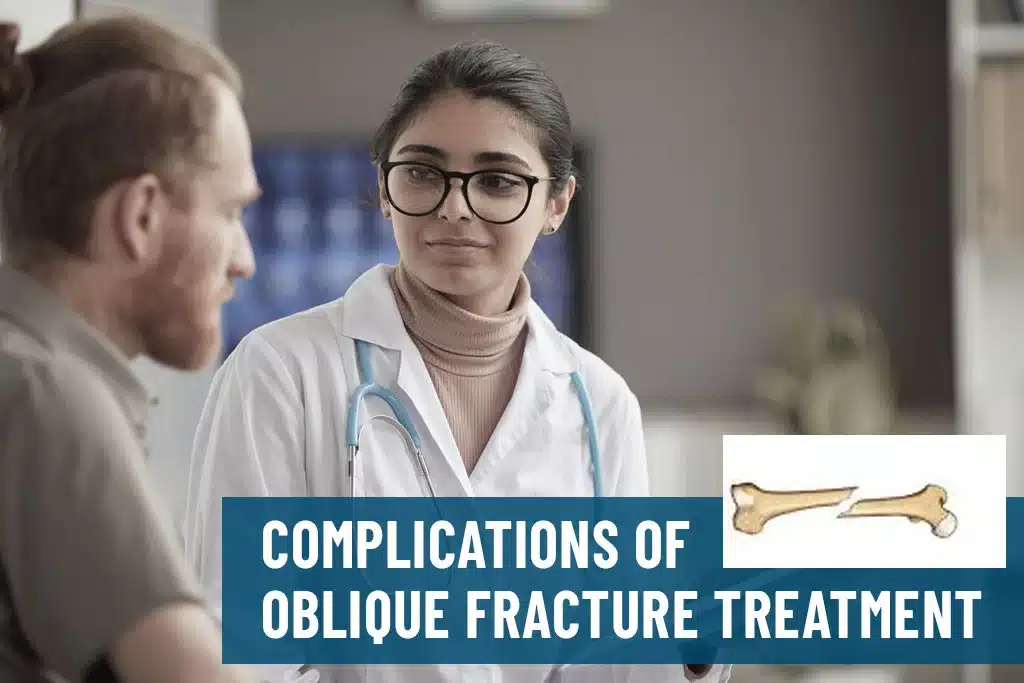
Oblique fracture surgery complications include:
Acute compartment syndrome (ACS): When pressure builds up enough to stop the supply of blood to tissue, this action can result in muscle disintegration which may lead to muscle and nerve injury.
Malunion: You may have issues with your broken bones not restoring properly during the healing process.
Nonunion: The way they form again may be different as each piece may not rejoin or could be replaced by metal plates and screws.
Bone infection (osteomyelitis): An open fracture (the bone fragments break through the skin), means the infection possibility is higher than any other type of fracture.
Other internal damage: Although fractures might hamper and tear the area surrounding your injury, including nerves, blood vessels, muscles, tendons, and ligaments as well.
How can I reduce my risk of an oblique fracture?
Follow these general safety tips to reduce your risk of injury:
- Always wear your seatbelt.
- Beware of the correct protection equipment for everything games and sports.
- Be careful with objects in your home and your workplace that can obstruct or cause a fall, especially any that might hinder you or others.
- Always use the correct tools or apparatus at home to reach things never with a ladder or a chair. Do not be the person who is standing on chairs, tables, or countertops.
- Be on a diet and exercise program that you can follow and will help you get strong and healthy bones.
- Talk to your doctor about having your bone density tested if you’re above the age of 50 or if you have a family with bone problems.
- If you have a problem with walking or attempting to avoid “incidents”, then use a cane or walker.
How can I prevent an oblique fracture?
Dischordial fractures are mostly due to falls and other sports mishaps. As a result, there’s not much you can do to prevent them. You can try a cane or walker to enhance your stability and limit the liability for falling to a great extent.
Firstly, if you have osteoporosis this type of treatment can considerably decrease the rate of your future bone density deterioration.
How long does it take an oblique fracture to heal?
It depends on the way the fracture was made as well as the therapies needed if you want to know how long it will take you to heal. The majority of the people with the fractured oblique muscle need several months for full recovery.
Many elements can control healing time in the body, regardless of the financial background. Talk to your doctor/surgeon about a schedule that is tailor-made to your type of surgery.
When should I go to the emergency room?
Suppose you feel you have a bent broken bone or any other broken bone type. In that case, you should visit a healthcare center or provider as between the time you break a bone and the time you are treated by a healthcare provider several things can happen which can lead to permanent damage or death. Go to the emergency room if you experience any of the following:
- Intense pain.
- Your body responds to the command that you are unable to move the side of your body.
- It seems someone has switched one of your body parts without telling you. Or maybe one body part is glacially slow and another is accelerating.
- There is the opportunity of looking at the bone with your eyes covered with skin.
- Swelling.
- The appearance of new bruises, lately, occurs together with other symptoms of this kind.
- Head to the emergency room as fast as you can if a major injury has just occurred to you.
Conclusion
An oblique fracture is usually a more or less affordable accident, but it’s frightening to see a bone crack, even though the event itself doesn’t change the life and can be easily fixed. Oblique fractures often get better and there are several ways to fix this correctly to ensure that your bones and body have healed by the time everything is finished. Remember to talk to your physician about how taking care of your bones is just as important as keeping your heart or lungs healthy, and if you are 50 years and older or have a family history of osteoporosis, ask for regular bone density screenings to catch this possibly debilitating condition early if it occurs. ER of Watauga is your go-to emergency room offering specialized care to your medical needs. Contact us now to book an appointment or to get further information.
FAQs
What distinguishes oblique fractures from other types of bone fractures?
An oblique fracture differs from the other two types of fractures, transverse and spiral because it is shorter and runs askew across the bone, not straight across or twisting around the bone. It will require unique ways of approaching therapy for this particular pattern, which is usually difficult to resolve.
How do oblique fractures occur, and what are the common causes behind them?
Oblique-type fractures are commonly the result of instant indirect trauma; the latter includes the case of the impact of an object or vice versa a sharp blow or sudden twist-and-bend of limbs. Sports injuries, mob falling and road abuse are frequent cases of these fractures, especially in long bones like femur or tibia.
What are the typical symptoms and signs associated with oblique fractures that individuals should watch out for?
Symptoms of an oblique fracture include localized pain, fractures, swelling, bruising, and also difficulty in bearing weight on the affected limb Moreover, it is not uncommon for individuals to discover an abnormal angle formation or deformity where the fracture has occurred due to the assault.
Can oblique fractures heal without surgery, or is surgical intervention often necessary?
The approach of straightening the fracture in case of some oblique fractures using conservative treatment like immobilization of the fractured area using a cast or braces is usually ineffective. However, surgical intervention is usually required to reconstruct the bone accurately and to stabilize the fracture.
Are there any specific rehabilitation exercises or treatments recommended for individuals recovering from oblique fractures to regain strength and mobility?
Rehabilitation for an oblique fracture is based on restoring motion, power, and function with the approach including an individualized program designed and supervised by physical therapists. At first, the doctor will simply prescribe movements that are gentle and uncomplicated, and the complexity will grow as the healing proceeds.
